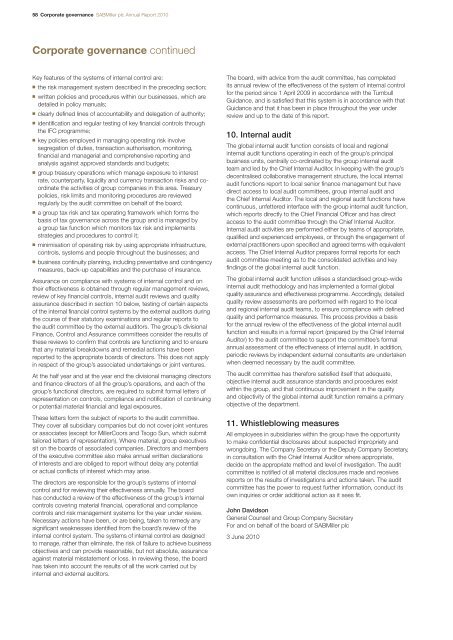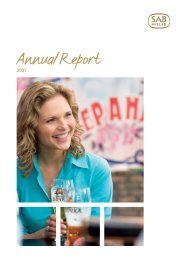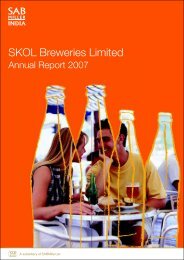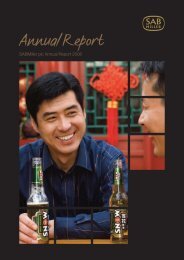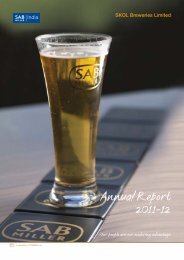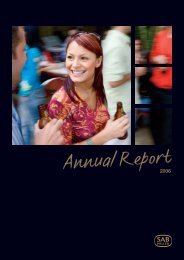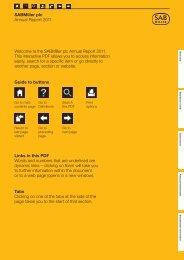58 Corporate governance <strong>SABMiller</strong> plc <strong>Annual</strong> <strong>Report</strong> 2010Corporate governance continuedKey features of the systems of internal control are:■ the risk management system described in the preceding section;■ written policies and procedures within our businesses, which aredetailed in policy manuals;■ clearly defined lines of accountability and delegation of authority;■ identification and regular testing of key financial controls throughthe IFC programme;■ key policies employed in managing operating risk involvesegregation of duties, transaction authorisation, monitoring,financial and managerial and comprehensive reporting andanalysis against approved standards and budgets;■ group treasury operations which manage exposure to interestrate, counterparty, liquidity and currency transaction risks and coordinatethe activities of group companies in this area. Treasurypolicies, risk limits and monitoring procedures are reviewedregularly by the audit committee on behalf of the board;■ a group tax risk and tax operating framework which forms thebasis of tax governance across the group and is managed bya group tax function which monitors tax risk and implementsstrategies and procedures to control it;■ minimisation of operating risk by using appropriate infrastructure,controls, systems and people throughout the businesses; and■ business continuity planning, including preventative and contingencymeasures, back-up capabilities and the purchase of insurance.Assurance on compliance with systems of internal control and ontheir effectiveness is obtained through regular management reviews,review of key financial controls, internal audit reviews and qualityassurance described in section 10 below, testing of certain aspectsof the internal financial control systems by the external auditors duringthe course of their statutory examinations and regular reports tothe audit committee by the external auditors. The group’s divisionalFinance, Control and Assurance committees consider the results ofthese reviews to confirm that controls are functioning and to ensurethat any material breakdowns and remedial actions have beenreported to the appropriate boards of directors. This does not applyin respect of the group’s associated undertakings or joint ventures.At the half year and at the year end the divisional managing directorsand finance directors of all the group’s operations, and each of thegroup’s functional directors, are required to submit formal letters ofrepresentation on controls, compliance and notification of continuingor potential material financial and legal exposures.These letters form the subject of reports to the audit committee.They cover all subsidiary companies but do not cover joint venturesor associates (except for MillerCoors and Tsogo Sun, which submittailored letters of representation). Where material, group executivessit on the boards of associated companies. Directors and membersof the executive committee also make annual written declarationsof interests and are obliged to report without delay any potentialor actual conflicts of interest which may arise.The directors are responsible for the group’s systems of internalcontrol and for reviewing their effectiveness annually. The boardhas conducted a review of the effectiveness of the group’s internalcontrols covering material financial, operational and compliancecontrols and risk management systems for the year under review.Necessary actions have been, or are being, taken to remedy anysignificant weaknesses identified from the board’s review of theinternal control system. The systems of internal control are designedto manage, rather than eliminate, the risk of failure to achieve businessobjectives and can provide reasonable, but not absolute, assuranceagainst material misstatement or loss. In reviewing these, the boardhas taken into account the results of all the work carried out byinternal and external auditors.The board, with advice from the audit committee, has completedits annual review of the effectiveness of the system of internal controlfor the period since 1 April 2009 in accordance with the TurnbullGuidance, and is satisfied that this system is in accordance with thatGuidance and that it has been in place throughout the year underreview and up to the date of this report.10. Internal auditThe global internal audit function consists of local and regionalinternal audit functions operating in each of the group’s principalbusiness units, centrally co-ordinated by the group internal auditteam and led by the Chief Internal Auditor. In keeping with the group’sdecentralised collaborative management structure, the local internalaudit functions report to local senior finance management but havedirect access to local audit committees, group internal audit andthe Chief Internal Auditor. The local and regional audit functions havecontinuous, unfettered interface with the group internal audit function,which reports directly to the Chief Financial Officer and has directaccess to the audit committee through the Chief Internal Auditor.Internal audit activities are performed either by teams of appropriate,qualified and experienced employees, or through the engagement ofexternal practitioners upon specified and agreed terms with equivalentaccess. The Chief Internal Auditor prepares formal reports for eachaudit committee meeting as to the consolidated activities and keyfindings of the global internal audit function.The global internal audit function utilises a standardised group-wideinternal audit methodology and has implemented a formal globalquality assurance and effectiveness programme. Accordingly, detailedquality review assessments are performed with regard to the localand regional internal audit teams, to ensure compliance with definedquality and performance measures. This process provides a basisfor the annual review of the effectiveness of the global internal auditfunction and results in a formal report (prepared by the Chief InternalAuditor) to the audit committee to support the committee’s formalannual assessment of the effectiveness of internal audit. In addition,periodic reviews by independent external consultants are undertakenwhen deemed necessary by the audit committee.The audit committee has therefore satisfied itself that adequate,objective internal audit assurance standards and procedures existwithin the group, and that continuous improvement in the qualityand objectivity of the global internal audit function remains a primaryobjective of the department.11. Whistleblowing measuresAll employees in subsidiaries within the group have the opportunityto make confidential disclosures about suspected impropriety andwrongdoing. The Company Secretary or the Deputy Company Secretary,in consultation with the Chief Internal Auditor where appropriate,decide on the appropriate method and level of investigation. The auditcommittee is notified of all material disclosures made and receivesreports on the results of investigations and actions taken. The auditcommittee has the power to request further information, conduct itsown inquiries or order additional action as it sees fit.John DavidsonGeneral Counsel and Group Company SecretaryFor and on behalf of the board of <strong>SABMiller</strong> plc3 June 2010
<strong>SABMiller</strong> plc <strong>Annual</strong> <strong>Report</strong> 2010 Remuneration report 59Remuneration reportIntroductionThis report and the recommendations of the remuneration committeehave been approved by the board and will be submitted to shareholdersfor approval at the 2010 annual general meeting. This report complieswith the requirements of the Large and Medium-sized Companiesand Groups (Accounts and <strong>Report</strong>s) Regulations 2008. Throughoutthe year ended 31 March 2010 the company applied the provisionsof the Combined Code relating to remuneration.Information not subject to auditComposition and terms of reference of theremuneration committeeDuring the year ended 31 March 2010, the members of the committeewere Mr Morland (Chairman), Lord Fellowes, Mr Manser and Mr Manzoni.Mr Bible, Mr Willard, Mr Santo Domingo and Mr Kahn joined meetingsas observers. Also present were the Chief Executive, Mr Mackay, theGeneral Counsel and Company Secretary, Mr Davidson, the DeputyCompany Secretary, Mr Shapiro, and the Group Head of Compensationand Benefits, Mr Scoones, except when their own remuneration wasdiscussed. Mr Armour joined the committee on 19 May 2010.The committee deals with the remuneration of the executive directorsand other members of the executive committee, as well as approvingall grants under the company’s share incentive plans, in accordancewith terms of reference approved by the board. Consideration is alsogiven to the company’s group-wide compensation and incentivepolicies to ensure alignment. When setting the remuneration ofexecutive directors, the committee has the discretion to considercorporate performance on environmental, social and governanceissues, and has oversight to ensure that the incentive structure forsenior management does not raise environmental, social or governanceissues by inadvertently motivating irresponsible or short-term behaviour.AdvisersIn the course of its deliberations, the committee considered theviews of the Chief Executive on the remuneration and performanceof the members of the executive committee. The Company Secretaryand the Group Head of Compensation and Benefits also providedinformation to the committee on the co-ordination of global paypolicies, expatriate and local pay for international deployments,equity usage through share incentive plans and on legal, regulatoryand governance issues.Kepler Associates has been appointed by the committee to provideadvice on long-term incentive design, information on current marketpractices, and metrics on performance conditions, specifically relativeTSR and other remuneration matters. Kepler Associates does notprovide any other advice or services to the group.Review of the group’s remuneration policiesThe committee last reviewed the overall structure of the group’sremuneration policies in 2006, when it adopted policies which weredesigned to target executive directors’ total compensation at or nearthe comparative upper quartile if the group achieved upper quartileperformance. In accordance with its expressed intention to reviewthe structure of the group’s remuneration policies at approximatelythree-yearly intervals, the committee conducted a detailed reviewduring the second half of the year ended 31 March 2010 to ensurethat remuneration structures remained appropriate and continuedto focus on alignment with shareholders’ interests and linkage to<strong>SABMiller</strong>’s long-term strategic goals. The committee was guided bythe philosophy that shareholder interest and shareholder alignmentshould be placed at the forefront, alongside the need to reaffirm thatsenior executives, within the bounds of appropriate governancelimitations, would have confidence that the incentive plans woulddeliver superior reward for superior performance, and little or noincentive reward for average or under-performance.On balance, the committee concluded that its policy of agreeing atotal remuneration package for each executive director comprisingan annual base salary, a short-term incentive in the form of an annualcash bonus, long-term incentives through participation in share incentiveplans, pension contributions, other usual security and health benefits,and benefits in kind, continued to be appropriate. The committeeconcluded that there was no requirement to change its approach tothe setting of base salaries, pensions and other benefits, which wereintended to establish a level of fixed pay which is competitive withappropriate global comparators. The committee also concluded thatthe variable pay elements provided by short-term and long-termincentives (LTI) should continue to form a significant proportion of executivedirectors’ pay, and that most aspects of the current incentive designworked well together to align the interests of the executive directorsand executive committee members with the interests of shareholders.However, the committee determined that it could further strengthenalignment of senior executives with shareholder interests by modifyingthe TSR-based performance share component of the overall package.The committee proposed that the relative TSR performance conditionshould be replaced with a new TSR-based performance condition,to be communicated to shareholders and senior executives as a‘Value Sharing’ performance condition, under which executives willbe given the right to receive a pre-defined number of shares for each£10 million of additional shareholder value delivered over the life ofan award. Additional shareholder value is defined as growth in marketcapitalisation of <strong>SABMiller</strong> (plus net equity cash flows) in excess of theperformance of the weighted median of a group of peer companies.To the extent that surplus value above the median is created, executiveswill be able to exercise these awards at quarterly intervals betweenyears three and five of the performance period. However, unlike theexisting TSR-based performance condition, under which 25% of theawards vest on reaching the median performance of the relevantcomparator group and 100% vest on reaching upper quartileperformance, no awards will vest at median performance under thenew performance condition. On the other hand, executives will be ableto continue earning additional shares to the extent that performanceexceeds the upper quartile (with an overall cap at the point at whichthe out-performance above the median equals the company’s initialmarket capitalisation). In effect, the committee decided that executiveswould receive no value for performance that is at median, and lessvalue for performance that is just above median, but would have theopportunity to earn more for performance which exceeds the upperquartile or upper decile.The principles underlying the proposed new Value Sharing conditionwere reviewed with the company’s two largest shareholders, holdingbetween them approximately 43% of the company’s shares, whoexpressed their support for the proposed change. The committeethen commenced a process of consultation and discussion bywriting to the company’s next 10 largest shareholders and to selectedinstitutional investor representative bodies to set out the details of theproposed change, to provide them with the opportunity to commenton the proposal, and to offer to discuss any concerns or questionswhich shareholders might have. Three shareholders accepted theinvitation to engage in discussions, and each expressed themselvesto be broadly supportive of the proposed change in principle, whileoffering differing and sometimes conflicting views on a number ofaspects either of the proposed change or other aspects of the group’swider remuneration structure. In addition, one shareholder submittedwritten comments, and the Association of British Insurers submittedwritten comments on behalf of a number of its members collectively.All of the points raised in discussions and in writing were consideredin detail by the committee, and the committee is grateful to thoseshareholders for taking the time to engage with the committee andfor providing their input.Overview Business review Governance Financial statements Shareholder information


